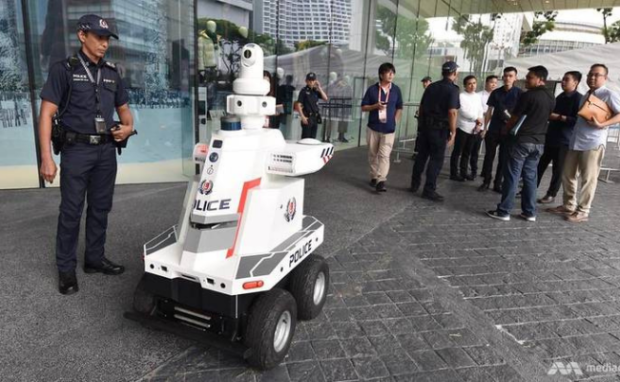Police robots keep Singapore Airport safe
If you want to see Robocop in real life, head to Changi Airport Terminal 4. On June 15, 2023, Channel News Asia reported the Singapore Police Force added two new patrol robots in April to help frontline officers. Moreover, the SPF announced it would roll out more bots across the Southeast Asian city-state.
Expect robots to become more prevalent daily as countries like Singapore adopt such technologies. This country is a major tourist attraction that may inspire more airports to have robot security. Soon, we will have more bots assisting us with various tasks.
In response, you must understand how they could impact your life. This article will elaborate on the Changi Airport security robots. Then, I will share an expert’s opinion on the risks and limitations of these machines.
What are the features of the Singapore Police robots?
At more than 7 feet tall when fully extended and with 360 degree vision they’re formidable enough to make any would-be lawbreaker think twice. https://t.co/ZPYFXTLU9z
— CNN (@CNN) June 18, 2023
According to the Channel News Asia website, these robots were prototypes from Project MATAR (Multi-purpose All-Terrain Autonomous Robot). As the name suggests, these machines patrol Changi Airport without human controllers.
These police robots have a camera with a 360-degree field of view. It is on an extendable mast that can reach up to 2.3 meters, giving officers a wider view of the robot’s surroundings.
In other words, these robots serve as extra eyes on the ground. Also, civilians may push a button on the front of the robot to contact airport police directly.
Then, an operations room officer will respond immediately. These police robots also broadcast audio messages with their speakers and display warnings on their LCD panels.
Consequently, they can inform nearby bystanders of a “Police Operation in Progress” or other activities. They also have sirens and blinkers that enable them to enforce a cordon.
You may also like: Nullspace Robotics Opens In Manila
For example, the robot may tell the public to avoid a suspicious bag left unattended in the terminal. Its camera also livestreams footage, and the operations room keeps recordings for 30 days.
Superintendent of Police Lim Ke Wei said on the official SPF website, “The integration of robotics enhances the operational efficiency and capabilities of our frontline officers, enabling them to be more effective in their duties.”
According to CNA, he told reporters, “The operationalization of patrol robots at Changi Airport… represents a significant milestone via exploration of robotics and policing. The patrol robots operate autonomously alongside our officers, providing additional eyes on the ground.”
What are the limitations of police robots?

Photo Credit: news.nestia.com
News regarding Singapore’s latest robo-security sparked the interest of numerous robotics experts. Helge Wurdemann, Professor of Robotics from the University College London, is one of them.
He shared his reaction to the police robots with the UK news outlet iNews. He expressed concerns about these machines promoting unease among people in Changi Airport.
“The people might get a feeling of being continuously monitored and recording,” the professor said. “These ‘fears’ need to be addressed and seriously considered when moving towards applications like the robot cops.”
Singapore’s robots prove that more countries are adopting robots. Yet, Wurdemann stated large-scale deployment on city streets is not yet feasible.
“An open environment is more uncontrolled and ‘extreme’ from a robotics research perspective – there are more challenges, and the [programmers] would have to account for many different types of surfaces and incidences that might occur. Challenges are very similar to challenges that the roll-out of autonomous vehicles faces,” he explained.
For example, some robots may struggle to traverse crooked outdoor paths or pothole-filled roads. Also, it must know how to respond to stray animals and people who may try to break it.
You may also like: The Top 10 AI Careers For Non-Techies
Some folks fear sci-fi films “Robocop” or “Terminator” becoming true in real life. However, the professor explained robots could “go rogue” depending on the humans behind them.
“Most importantly, the robot will not be making any judgments. As many algorithms are data-driven, the outcome significantly depends on the data they have been fed with. Hence, there is the challenge and concern of having biased data set resulting in undesirable outcomes.”
“Keeping the experiences human is crucial here. And the research and tech are moving towards this, where one human is sitting in an operating room with full control over all the vehicles, and they can take over control from the vehicle, based on their senses and judgment.”
Conclusion
Singapore’s Changi Airport deployed two new robots to secure and protect travelers. The local police force says they only augment frontline officers.
Robots are tools that only become good or bad, depending on their human operators. Thus, we must train and design these machines to fully benefit humans.
That is only possible with further research, development, and widespread adoption of robotics daily. Learn more about other digital trends at Inquirer Tech.